From coffee machine to hanging-ear coffee: several innovative inventions about coffee
For professional baristas, please follow the coffee workshop (Wechat official account cafe_style)
For modern people, it is not difficult to have a cup of coffee anytime and anywhere. If you want to brew a cup of espresso (espresso) at home, there are a wide variety of household coffee machines to choose from, but when you taste the dense and delicate coffee cream (crema), have you ever wondered who first invented the espresso coffee machine?
Coffee beans are a major commodity in global trading volume second only to crude oil, which can create a sales market of up to 42.5 billion US dollars for the world every year. 125 million people in the world depend on coffee for their livelihood, and coffee export is the economic lifeline of many countries. In Taiwan, coffee has become the daily necessities of many people, and coffee consumption is also increasing year by year. It is estimated that the economic benefit of coffee in one year is about NT $60 billion. It is not too much to call coffee the "new black gold" (new black gold).
Figure 1. New Black Gold-Coffee
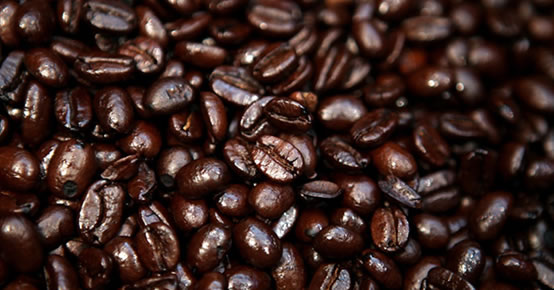
According to experts in coffee history, the first espresso coffee machine was unveiled by the Italian Angelo Moriondo at the Turin Expo in 1884. This machine can control the supply of steam and water through coffee. Mr. Moriondo also obtained a six-year patent on May 16 of the same year, patent number 33256, patent name New Steam Machinery for the Economic and Instantaneous Confection of Coffee Beverage, Method A. Moriondo (see figure II), and for the next few years. He continued to improve the machines, and all of them were patented, but none of them were produced commercially.
Figure 2. Angelo Moriondo's patent for coffee maker
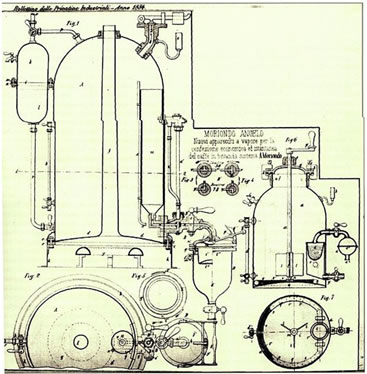
In 1901, another Italian, Luigi Bezzera, wanted to know how long it would take to wait for the machine to brew a cup of coffee, so he tried to add steam pressure to the machine, which not only greatly shortened the time of brewing coffee, from 4 minutes to 30 seconds, but also made a stronger coffee, so he obtained a patent named Innovations in the Machinery to Prepare and Immediately Serve Coffee Beverage on June 5, 1902. The patent number is 153Compact 94, 61707 (see figure III). But the promotion of this modified coffee machine was limited because Mr. Bezzera was not good at marketing, so in 1905, the above patent was sold to an Italian businessman, Desiderio Pavoni (the founder of La Pavoni), and began to market at the rate of producing one machine a day, changing the way Italians drink coffee and eventually affecting the world.
Figure 3. Luigi Bezzera coffee machine patent and La Pavoni coffee machine
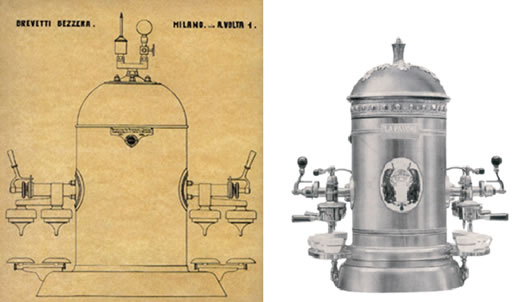
The basic structure of the espresso coffee machine now on the market is derived from the Italian Achille Gaggia's patent on the steamless coffee machine applied for on September 5, 1938, with patent number 365726 (see figure 4). Before that, the coffee machine used steam high pressure to push hot water through the coffee, while Mr. Gaggia's coffee machine used a spring device and a piston to allow hot water to pass through the coffee under high pressure in a stable and constant pressure, and an espresso could be extracted in 15 seconds. Mr Gaggia is said to have been inspired by observing the hydraulic system of the US jeep engine.
Figure 4. Achille Gaggia's patent for coffee maker

Satori Kato, a Japanese-American chemist, invented instant coffee (instant coffee) and its preparation in 1901, which could be made by simply adding water. This was indeed an innovative invention at that time, but few people liked the taste of the coffee, so Mr. Kato's coffee business was not successful. Satori Kato was granted a patent on August 11, 1903 under the patent number US735777 and the patent name Coffee Concentrate and Process of Making Same (see figure V).
Figure 5. Satori Kato's patent for instant coffee
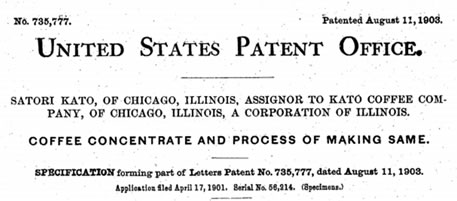
Satori Kato has long been recognized as the first inventor of instant coffee, but in 2012, New Zealand historians announced that David Strang, a New Zealander, was the first inventor. Mr. Strang invented instant coffee as early as 1889 and applied for a patent in 1890.
The better-known inventor of instant coffee is the naturalized British chemist George Constant Washington (see figure VI), who invented mass-produced instant coffee powder and its production method while raising cattle in Guatemala in 1906. Before that, Mr. George Washington had a number of patents for the invention of hydrocarbon lamps, but after the mass production of light bulbs, these lamps were no longer of value. Mr. Washington began to sell instant coffee powder in 1909, and the opportunity for him to gain both fame and fortune was during the first World War, when the United States military bought all the coffee powder produced by Mr. Washington and listed the Washington Coffee Company as an important supplier, while soldiers even jokingly called instant coffee a cup of George.
Figure 6. George Constant Washington was born and raised in Belgium

The invention of capsule coffee does not only bring people a more convenient way of coffee consumption, but also prolong the storage and preservation time of ground coffee powder. the most important thing is that the quality of brewed coffee is generally recognized. In recent years, with the blessing of big star advertisements and the demand of modern people to speed up and avoid cleaning up the aftermath, the sales of capsule coffee have been on the rise, but the controversy over the waste of resources and pollution caused by the capsule packaging that is lost as soon as it is used has never stopped. A few days ago, John Sylvan, the inventor of capsule coffee in the United States, even publicly said that he regretted inventing this capsule coffee, and he did not drink capsule coffee himself. this immediately became international news, of course, Taiwan media also followed up to report, because in recent years, Taiwan has also set off a trend of drinking capsule coffee, when the world is enjoying it easily and conveniently, how many people are also concerned about this environmental protection issue at the same time?
Capsule coffee was first invented by the Swiss Eric Favre in 1976, when Mr. Favre and his Italian wife, who worked at the headquarters of Nestl é in Switzerland, were espresso lovers and often traveled around Italy in search of the perfect espresso. In a queued restaurant in Rome, Mr. Favre observed the special machine operation of the coffee celebrity Mr. Eugenio, and Mr. Favre realized the principle that "before water comes into contact with coffee, it must contain a lot of air so that you can get a good cup of espresso" and developed the world's first coffee capsule. Nestl é filed a patent application called Capsule for Beverage Preparation with the United States Patent Office in 1977 and was granted the patent number US4136202 on January 23, 1979 (see figure 7).
Figure 7. Eric Favre Coffee capsule Patent

In order to solve the problem of a large number of disposable aluminum and plastics in coffee capsules, the Ethical Coffee Company of Switzerland (Ethical Coffee Company;ECC) invented coffee capsules made of corn starch as the shell material in 2008, while Lavazza Coffee Company of Italy published coffee capsules made of plants in March this year (2015) after five years of research and development, claiming to be the only new invention of its kind that can be completely degraded by biology.
Compared with the issue of capsule recovery of capsule coffee, it is also a kind of hanging-ear coffee, which is also aimed at providing convenience, but it is not controversial in environmental protection. Hang-ear coffee was invented by Yamanaka Industrial Co., Ltd., Japan, and formally filed a patent application in Japan in 1990 (see figure 8). Because the ear-hanging part is designed on the upper edge of the non-woven open filter bag and is only located on one side, the supporting force of the whole filter bag is uneven, so that when in use, the opening part can not be fully opened, and the consumer's use experience is not good, which can be regarded as a commercial failure.
Figure 8. The patent of ear filter bag of Yamanaka Industrial Co., Ltd.

Then in 1996, Daji Commercial Co., Ltd. proposed an improved filter bag, which moved the lug parts to the lower edge of the bag, but the lug was only on one side of the bag. In 1999, Daji applied to the European Patent Office for an invention patent with two-sided ear-hanging parts (see figure 9). This improved design finally allows the filter bag to stand firmly at the mouth of the cup, and the opening of the filter bag can be fully opened. solved the defects of the previous products, and this design concept has become the mainstream of today's market.
Figure 9. Daji Commercial Co., Ltd.'s patent for ear filter bags.

Finally, from the above examples, we should be able to feel that many inconveniences and deficiencies in daily life are most likely the source of creativity, because many inventions are made by inventors through observation and insight into the principle. To solve the problem by different and better means, after the realization of creativity, there are more important things, as each of the above coffee inventors has done. Only through patent protection can the value of invention be realized without worry.
references
Http://g.udn.com/NEWS/NATIONAL/NATS10/8532446.shtml
Http://en.wikipedia.org/wiki/Angelo_Moriondo
Http://www.espressocoffeeguide.com/instant-coffee/history-of-instant-coffee/
Http://en.wikipedia.org/wiki/Satori_Kato
Http://inventors.about.com/od/cstartinventions/a/coffee.htm
Https://www.patentplaques.com/blog/?p=494
Http://www.coffee-machine.org/coffee-machine-and-espresso-machine-history/
Http://www.gaggia.com/e/the-story.html
Http://su-gabee.blogspot.tw/2013/04/bag-for-extracting.html
Important Notice :
前街咖啡 FrontStreet Coffee has moved to new addredd:
FrontStreet Coffee Address: 315,Donghua East Road,GuangZhou
Tel:020 38364473
- Prev
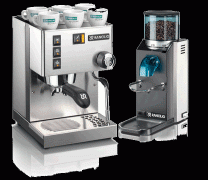
The structure and principle of household Italian coffee machine which brand of coffee machine is good and how to repair it?
Professional barista communication Please follow the coffee workshop (Wechat official account cafe_style) the origin of the Expresso coffee machine (Espresso means "fast" in Italian) can be traced back to 1901, the Italian manufacturing boss (Luigi Bezzera) invented the coffee machine in order to reduce the time employees spend cooking and waiting for coffee, in order to increase productivity.
- Next
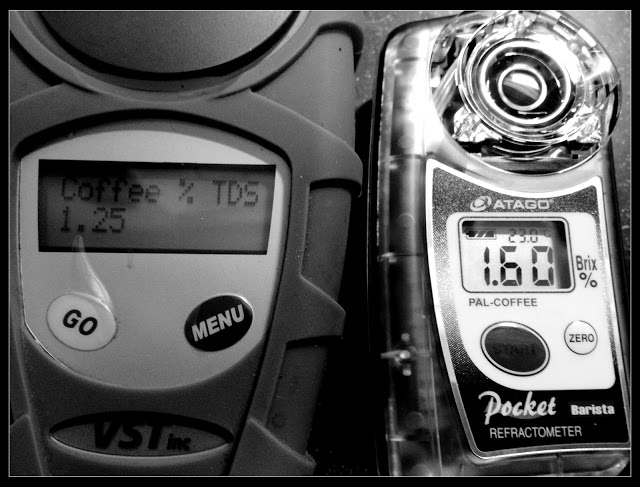
The principle and application method of measuring coffee concentration by the fastest and most accurate coffee concentration measuring instrument
Communication of professional baristas Please pay attention to the coffee workshop (Wechat official account cafe_style) there are many ways to measure coffee concentration, from the troublesome drying method, to the inaccurate conductivity meter or hydrometer, then to the conversion of sugar meter, and finally to VST's refractometer digital refractometer; from then on, it is generally accepted that this is the fastest and most accurate measuring equipment. Even after a few years
Related
- What is the Philharmonic pressure? How to use Philharmonic pressure to make delicious coffee
- Why does a hand grinder have more fine powder than an electric grinder?
- In addition to the hot mom, what is the difference between the versions of EK43 | ditting and Mahdi ek43?
- What kind of equipment do you need to make coffee by hand? Introduction to novice starter cooking equipment tools
- Espresso needs to be ground how thick and thin scale entry Italian Coffee Machine Bean Grinder investigation and Grinding course
- How much does it cost to open a small private cafe? How much does it cost to learn coffee? How to operate it?
- The difference between the flavor characteristics of hand-brewed coffee and coffee maker is hand-brewed coffee really better than coffee maker? Can I use a coffee machine to make coffee beans by hand?
- The difference between 01 and 02 of hario v60 filter cup what is the difference between 01 and 02 filter cup opening and cooking flavor
- What's the difference between the smart cup and the French kettle? Which is better, the French kettle or the Smart Cup?
- What's the difference between a smart cup and a V60 filter cup? The difference between the taste of smart cup and hand-brewed coffee

